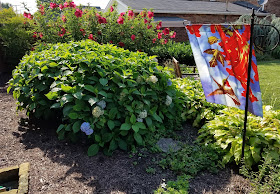Let's take a walk through my zone 7a garden and see what's new and blooming, shall we? Quite a bit has changed since my update on blooms last month. Caution: photos ahead!
Sharing: Amaze Me, DIDI, BNOTP, Show & Share, Inspire Me, Make it Pretty, The Scoop, Dream, Create, Inspire, Vintage Bliss Tuesdays, Thrifty & Vintage Finds, Celebrate Your Story, Let's Talk Vintage, Talk of the Town, SYC, Delightsome Life H&G, TOHOT, Vintage Charm, Foodie Friday & Everything Else, FNF
By the 4th of July, my annual beds and containers really begin filling out, which I love to see. I only used Miracle Gro a couple times this year, as we've had a lot of rain in addition to high temps and humidity.
As a result of the heat and humidity, the lawn begins to see little patches of Bermuda (the brownish spots) creep into our mostly fescue grass in July, which Mr. P. despises. He mows and edges our lawn, keeping it cut on the highest level with clippings back into the grass, in efforts to minimize the Bermuda grass. He also pulls it like weeds, but those roots run deep and wide. I realize lots of Southerners love Bermuda, but fescue works well for us, staying green year round.
As a result of the heat and humidity, the lawn begins to see little patches of Bermuda (the brownish spots) creep into our mostly fescue grass in July, which Mr. P. despises. He mows and edges our lawn, keeping it cut on the highest level with clippings back into the grass, in efforts to minimize the Bermuda grass. He also pulls it like weeds, but those roots run deep and wide. I realize lots of Southerners love Bermuda, but fescue works well for us, staying green year round.
In addition to my annuals filling out by the 4th, another thing I look forward to is seeing my hibiscus plants starting to bloom.
The photo above shows two opposite corners of the landscape, with the front plants (L) about two weeks behind in growth and blooms when compared to the back landscape plants (R), both taken in early July. By late July they are both at full maturity and bloom rate (see photo below of front hibiscus, taken this past week).
All the staking I did through May and June pays off when the strong thunderstorms of June and July come along. The hibiscus remain upright, with blooms toward the sun.
All the staking I did through May and June pays off when the strong thunderstorms of June and July come along. The hibiscus remain upright, with blooms toward the sun.
My last update on blooms also showed my containers just after planting. They've grown!
I have two pairs of each of the containers pictured above. Here's a comparative photo (below), showing early June to mid-July:
It wasn't until this past week in July that my plumes on my purple fountain grasses emerged in my containers.
In June, my bee balm and black-eyed Susans were just starting to come in, and below is what they looked like by mid-July. You can see a few coneflowers mixed in, as well as the butterfly bush on the right. First flush of spirea blooms in foreground are mostly spent at this point.
In June, my bee balm and black-eyed Susans were just starting to come in, and below is what they looked like by mid-July. You can see a few coneflowers mixed in, as well as the butterfly bush on the right. First flush of spirea blooms in foreground are mostly spent at this point.
By late July, the bee balm were looking peaked, with leaves yellowing, stalks drooping from strong storms, and flower heads sucked dry by hummers and heat. I cut them down this past week, and you can see the difference in the freed up space when comparing the photo above and below.
In the photo below, you can see I have butterfly bushes in both dwarf (top right frame of collage) and tree form (bottom frame of collage) in my landscape.
In the photo below, you can see I have butterfly bushes in both dwarf (top right frame of collage) and tree form (bottom frame of collage) in my landscape.

My knockout roses are trained to grow upward behind my dwarf butterfly bushes (behind trellises of top right frame in above photo). My buttercups were behind the three tree butterfly bushes, and they were cut down in mid-July to control spreading after the blooms were spent.
The arch trellis is just beyond the dwarf butterfly plants, and is still slow growing. As the magnolia next to it is growing bigger, it's been harder to realize full sun exposure and coverage on the trellis as quickly as I'd like to see. I added some moonflower vine seeds, though a little late, this year. I've made mental (and written) notes on that for next year's planning.
My hydrangeas are looking pretty good this year (photo below), much better than the past three years. I have zero regrets for removing three of those plants this past March, and another one in a year prior to that.
These plants are huge, and they are at the farthest back placement in the landscape, just to the left of my blooming hibiscus. They make a nice 4th of July display with the hibiscus and flag. Hostas in the foreground will begin blooming in early August.
Shortly after the 4th, I typically change out my flag for variety.
As you can see below, I now have room to walk behind my hydrangeas, which was impossible before the purge.
A couple of newbies in the July garden this year are Mexican sunflowers and a family of baby robins. It's been fun watching both grow. The variety of birds and nests in our area seem to be prolific this year. So are the mosquitoes! Thankfully, the dragonflies are plentiful too and, based on their jet propulsive flights across my lawn, they're doing the best they can to keep the mosquito population contained.
Originally, I planted the Mexican sunflowers from pass along seeds. My intention was to fill in the space in the back landscape, opposite from the hibiscus, but visible beyond the butterfly bushes, near where the bright yellow buttercups were (see June post for buttercups in bloom). The plants are still growing, and the first bloom in the back just appeared on July 21.
Often with a first year of a new planting, the blooms are fewer, but I guess I'm being a little greedy. I want many more blooms before the season plays out!
I also planted the Mexican sunflowers on the opposite side of the landscape, where the hibiscus are going crazy with blooms. They began blooming sooner, so there are more flowers on those plants. You can see below - salvia, sedum, and the Mexican sunflowers are next to more black-eyed Susans (also on opposite side of landscape). There's also lavender and English laurel (Otto Luykens), just in front of the hibiscus.
Hopefully I'll have a nice pop of that fiery orange bloom on both sides by August and into September. I love that complementary orange against the blue sky!
Lavender has been harvested and dried continually through June, and is now slowing down a bit in July, and all of those plants seem to be doing well, too. Courtyard roses were cut back once the first flush of blooms were spent in June, and they're blooming again, though not as full as before.
There's still a little lizard family among my courtyard lavender and roses, but there are also other critters and creatures typically sighted among my landscape beds during July.
The garden spiders and butterflies are welcome (in the garden, NOT on my porch and windows!), the bunnies are annoying, but it's the praying mantis I watch closely, especially when they're anywhere near my hummingbird feeders. Please read this post I wrote if you are unaware of their danger to hummers. I know they're beneficial insects for the most part, but they can be predatory toward hummers.
I've still been fortunate this gardening season NOT to have any poison ivy breakouts. I do see it, and I do pull it from my garden. However, this year I have been keenly aware and very ritualistic in my routine afterward - I stop, go inside, use a nail brush and poison ivy soap and scrub with cool water. Then I remove my gloves and do the same with my bare hands. I have even scrubbed my forearms, ankles and up to my knees, depending on how high the plantings are where I've been. The yard waste bag is tied up once the ivy is in it.
A neighbor sent this poison ivy quiz to me just this past week, and I'll pass the link along to you from a great website. Go ahead, test your knowledge. Let me know how you did. The photo below is mine, but the caption should refer you to the website. Note: it only demonstrates eastern varieties.
 |
| Poison Ivy Quiz |
Thanks for joining me in my Zone 7a garden walk for July. I'm always interested in reading others' posts on their gardens, how the season is unfolding, and the differences in our timing of plants in the various regions. I ♥ my garden! I appreciate your readership and comments, too!
Rita C. at Panoply

























No comments:
Post a Comment